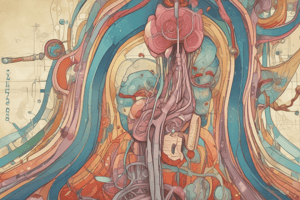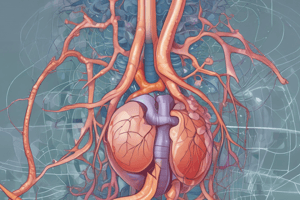Podcast
Questions and Answers
What is the primary action of thiazide diuretics in the kidneys?
What is the primary action of thiazide diuretics in the kidneys?
- They increase Mg2+ reabsorption.
- They block K+ reabsorption.
- They promote Na+ and K+ wasting.
- They inhibit reabsorption of Na+ and Cl−. (correct)
Thiazide diuretics can decrease calcium reabsorption in the kidneys.
Thiazide diuretics can decrease calcium reabsorption in the kidneys.
False (B)
Name two conditions for which thiazide diuretics are commonly used.
Name two conditions for which thiazide diuretics are commonly used.
high blood pressure, congestive heart failure
Thiazide diuretics are ____ sensitive Na+-Cl− symporter inhibitors.
Thiazide diuretics are ____ sensitive Na+-Cl− symporter inhibitors.
Match the following diuretics to their respective characteristics:
Match the following diuretics to their respective characteristics:
Which diuretic acts primarily on the Loop of Henle?
Which diuretic acts primarily on the Loop of Henle?
Thiazide diuretics act on the collecting duct of the nephron.
Thiazide diuretics act on the collecting duct of the nephron.
What is the mechanism of action for loop diuretics?
What is the mechanism of action for loop diuretics?
Loop diuretics primarily increase the concentration of ions in the ______.
Loop diuretics primarily increase the concentration of ions in the ______.
Match each type of diuretic with its site of action:
Match each type of diuretic with its site of action:
What percentage of the filtered load of Na+ is reabsorbed in the thick ascending limb (TAL)?
What percentage of the filtered load of Na+ is reabsorbed in the thick ascending limb (TAL)?
Carbonic anhydrase inhibitors act on the Loop of Henle.
Carbonic anhydrase inhibitors act on the Loop of Henle.
Name a common loop diuretic.
Name a common loop diuretic.
What ion loss is associated with alkalosis in compensatory actions?
What ion loss is associated with alkalosis in compensatory actions?
Digoxin toxicity can result in increased intracellular calcium concentration.
Digoxin toxicity can result in increased intracellular calcium concentration.
Which plant is the source of Digoxin?
Which plant is the source of Digoxin?
Digoxin acts as an inhibitor of the Na+/K+ _____ pump.
Digoxin acts as an inhibitor of the Na+/K+ _____ pump.
Which condition can potentiate the effect of Digoxin and increase the risk of cardiac arrhythmias?
Which condition can potentiate the effect of Digoxin and increase the risk of cardiac arrhythmias?
Match the following components with their respective functions:
Match the following components with their respective functions:
Aldosterone receptor antagonists promote Na+ reabsorption.
Aldosterone receptor antagonists promote Na+ reabsorption.
What is the therapeutic window for Digoxin in µg/L?
What is the therapeutic window for Digoxin in µg/L?
What mechanism do thiazides primarily affect in the kidneys?
What mechanism do thiazides primarily affect in the kidneys?
Thiazides increase the clearance of uric acid in patients with gout.
Thiazides increase the clearance of uric acid in patients with gout.
What condition is NOT listed as a contraindication for thiazide diuretics?
What condition is NOT listed as a contraindication for thiazide diuretics?
Thiazides cause __________ potassium levels while conserving blood calcium.
Thiazides cause __________ potassium levels while conserving blood calcium.
Match the following conditions with their effects of thiazide diuretics:
Match the following conditions with their effects of thiazide diuretics:
Increased aldosterone activity due to thiazide use primarily leads to:
Increased aldosterone activity due to thiazide use primarily leads to:
Thiazides directly inhibit the Na+/Ca2+ antiporter in the distal convoluted tubule.
Thiazides directly inhibit the Na+/Ca2+ antiporter in the distal convoluted tubule.
What effect do thiazides have on blood calcium levels?
What effect do thiazides have on blood calcium levels?
What adverse effect is primarily associated with potassium-sparing diuretics?
What adverse effect is primarily associated with potassium-sparing diuretics?
Potassium supplements can be safely prescribed alongside potassium-sparing diuretics.
Potassium supplements can be safely prescribed alongside potassium-sparing diuretics.
Which diuretic type is often used in combination with loop diuretics and thiazides to reduce potassium loss?
Which diuretic type is often used in combination with loop diuretics and thiazides to reduce potassium loss?
Hyperkalaemia can lead to cardiac ______.
Hyperkalaemia can lead to cardiac ______.
Match the following components with their associated actions:
Match the following components with their associated actions:
Which of the following statements is true regarding ENaC?
Which of the following statements is true regarding ENaC?
Aldosterone is secreted in response to hyponatremia.
Aldosterone is secreted in response to hyponatremia.
What effect does spironolactone have on sodium and potassium levels?
What effect does spironolactone have on sodium and potassium levels?
Flashcards
Thick Ascending Limb
Thick Ascending Limb
Part of the nephron responsible for active transport of Na+, K+, and Cl- out of the lumen and into the interstitium, making the interstitium more positive.
NKCC2
NKCC2
Sodium-potassium-2 chloride cotransporter, a protein in the thick ascending limb that pumps sodium, potassium, and chloride out of the lumen.
Loop diuretics
Loop diuretics
Medications (e.g., furosemide) that block NKCC2, leading to increased urine output by preventing reabsorption of electrolytes.
Thiazide diuretics
Thiazide diuretics
Signup and view all the flashcards
Role of Diuretics in High blood pressure & Edema
Role of Diuretics in High blood pressure & Edema
Signup and view all the flashcards
Loop Diuretics Site of Action
Loop Diuretics Site of Action
Signup and view all the flashcards
Loop Diuretics Mechanism
Loop Diuretics Mechanism
Signup and view all the flashcards
Loop Diuretics Effect on Na+ and Cl-
Loop Diuretics Effect on Na+ and Cl-
Signup and view all the flashcards
Loop Diuretic Diuretic Action
Loop Diuretic Diuretic Action
Signup and view all the flashcards
Thiazide Diuretics Site of Action
Thiazide Diuretics Site of Action
Signup and view all the flashcards
Thiazide Diuretics Mechanism
Thiazide Diuretics Mechanism
Signup and view all the flashcards
Osmotic Diuretics Site of Action
Osmotic Diuretics Site of Action
Signup and view all the flashcards
Osmotic Diuretics Mechanism
Osmotic Diuretics Mechanism
Signup and view all the flashcards
Thiazide diuretic action
Thiazide diuretic action
Signup and view all the flashcards
Thiazide effect on uric acid
Thiazide effect on uric acid
Signup and view all the flashcards
Thiazide-induced hyperglycemia
Thiazide-induced hyperglycemia
Signup and view all the flashcards
Thiazide potassium loss
Thiazide potassium loss
Signup and view all the flashcards
Thiazide contraindications
Thiazide contraindications
Signup and view all the flashcards
Aldosterone's role with thiazides
Aldosterone's role with thiazides
Signup and view all the flashcards
Mechanism of potassium loss with thiazides
Mechanism of potassium loss with thiazides
Signup and view all the flashcards
Hypotension contraindication for Thiazides
Hypotension contraindication for Thiazides
Signup and view all the flashcards
K+ sparing diuretics
K+ sparing diuretics
Signup and view all the flashcards
Adverse Effects of K+ sparing diuretics
Adverse Effects of K+ sparing diuretics
Signup and view all the flashcards
Interaction with ACE inhibitors
Interaction with ACE inhibitors
Signup and view all the flashcards
ENaC
ENaC
Signup and view all the flashcards
Aldosterone's Role in Sodium Reabsorption
Aldosterone's Role in Sodium Reabsorption
Signup and view all the flashcards
Spironolactone's Mechanism
Spironolactone's Mechanism
Signup and view all the flashcards
Spironolactone's Impact on Potassium
Spironolactone's Impact on Potassium
Signup and view all the flashcards
Hyperkalemia and Cardiac Arrhythmias
Hyperkalemia and Cardiac Arrhythmias
Signup and view all the flashcards
Digoxin
Digoxin
Signup and view all the flashcards
Na+/K+ ATPase Pump
Na+/K+ ATPase Pump
Signup and view all the flashcards
Digoxin Toxicity
Digoxin Toxicity
Signup and view all the flashcards
Hypokalaemia
Hypokalaemia
Signup and view all the flashcards
Aldosterone Antagonists
Aldosterone Antagonists
Signup and view all the flashcards
Na+ Channel Inhibitors
Na+ Channel Inhibitors
Signup and view all the flashcards
Depolarisation
Depolarisation
Signup and view all the flashcards
Study Notes
Drugs and Membrane Transporters: Renal Transport Systems
- Renal transport systems are crucial for drug action and excretion.
- Loop diuretics, thiazide diuretics, and potassium-sparing diuretics affect renal function.
Learning Objectives
- Students should understand the site of action, mechanism of action, and side effects of loop, thiazide, and potassium-sparing diuretics.
Further Reading
- Medical Physiology, 3rd Edition, Chapter 35 (Transport of Sodium and Chloride, pp 1111-1116)
- Rang and Dale's Pharmacology, 10th edition, Chapter 29 (The Kidney and Urinary System, pp 402-412)
Site and Mechanism of Action
- Diuretic: Site of Action: Mechanism of Action:
- Osmotic diuretics: Proximal tubules Inhibition of water and Na+ reabsorption
- Carbonic anhydrase inhibitors: Proximal tubules Inhibition of bicarbonate reabsorption
- Loop diuretic: Loop of Henle (thick ascending limb) Inhibition of Na+, K+, and Cl− reabsorption
- Thiazide: Early distal tubule Inhibition of Na+, Cl− co-transport
- K+ sparing diuretics: Late distal tubule/collecting duct Inhibition of Na+ reabsorption
Loop Diuretics
- Example drugs: Furosemide, bumetanide
- Mechanism: Inhibit the Na+/K+/2Cl− co-transporter (NKCC2) in the thick ascending limb of Henle's loop.
- This reduces Na+ and Cl− reabsorption.
- 25% of filtered Na+ is normally reabsorbed in this section, so loop diuretics have a significant effect.
- This leads to a decrease in the concentration of ions in the tubule and reduced hypertonicity in the surrounding interstitium, which impacts water reabsorption.
Thiazide Diuretics
- Example drugs: Hydrochlorothiazide, chlorothiazide, bendroflumethiazide
- Mechanism: Block the thiazide-sensitive Na+-Cl− symporter in the early distal convoluted tubule.
- This inhibits Na+ and Cl− reabsorption.
- Also increase Ca2+ reabsorption in the distal tubule.
K+ Sparing Diuretics
- Mechanism: Aldosterone antagonists (e.g., spironolactone, eplerenone) block aldosterone's effect on Na+/K+ATPase and ENaC, reducing Na+ reabsorption and K+ secretion.
- Na+ channel inhibitors (e.g., amiloride, triamterene) block ENaC, reducing Na+ reabsorption and thus also K+ secretion to a lesser extent.
Contraindications
- Thiazides: May worsen gout, renal failure, hypokalemia, and may worsen diabetes.
- K+ Sparing Diuretics: Hyperkalemia, a potential adverse effect, is a concern when used with other drugs that also elevate potassium levels, such as ACE inhibitors
Digoxin Toxicity
- Digoxin inhibits the Na+/K+ ATPase pump, leading to increased intracellular Na+, reduced Na+/Ca2+ exchange and increased intracellular Ca2+.
- This can cause cardiac arrhythmias.
- Loop and thiazide diuretics may increase the risk of digoxin toxicity.
Blood Electrolyte Balance
- For reference, normal ranges for blood electrolytes (e.g., Na+, K+, Cl-, Ca2+, Mg2+).
Studying That Suits You
Use AI to generate personalized quizzes and flashcards to suit your learning preferences.
Related Documents
Description
Explore the mechanisms and effects of various diuretics on renal transport systems in this quiz. Understand the action sites and side effects of loop, thiazide, and potassium-sparing diuretics, drawing from the key concepts in medical physiology and pharmacology. Perfect for students aiming to master renal pharmacology.




